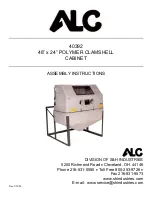
40392 Assembly Instructions
Page 5
CABINET BLASTER SAFETY PROCEDURES
CAUTION: R
EAD THESE SAFETY PROCEDURES IN THEIR ENTIRETY
–
PARTS OF THE
O
PERATING
I
NSTRUCTIONS ARE WITHIN THESE
W
ARNINGS
.
These procedures are not intended to be exhaustive due to the many variables in the abrasive
blasting field. Therefore, we INSIST that the hands, ears, mouth, nose and eyes be covered with
appropriate safety protection at all times.
ADDITIONAL WARNINGS!
CAUTION MUST BE EXERCISED BY USER AT ALL TIMES
1.
Do not exceed maximum working pressure of 110 PSI. Failure to keep maximum
working pressure below 110 can cause the blast machine to burst, causing death or
serious injury.
2.
Everyone in the blast area including the equipment operator should correctly use and
maintain a NIOSH approved air supplied respirator, even after blasting has ceased.
Harmful dust can remain suspended in the air for long periods of time after blasting
has ceased causing injury or death
3.
Before using the pressure blaster: Put on eye protection, gloves, and NIOSH approved
respirator. Always wear these protective items when operating and while servicing
your abrasive blaster. A well maintained air supplied blasting respirator must be used
by anyone blasting.
4.
For safe operation, perform recommended preventive maintenance on blaster cabinet,
and accessories. Replace all worn parts before they fail. Immediate replacement of
worn components is required. Failure to replace worn components could result in
exposing the operator or bystanders to high speed media and compressed air, causing
serious injury.
5.
Do not use corrosive materials of any type in unit. Use only clean, dry media.
6.
Static electricity can be created by the use of this equipment. Do not use within fifty
feet of any explosive, potentially explosive substances, or their vapors as an explosion
can occur.
7.
Do not use this equipment in any area that might be considered hazardous or where
flammable gases or liquids are present. Failure to do so may cause an explosion
resulting in serious injury.














